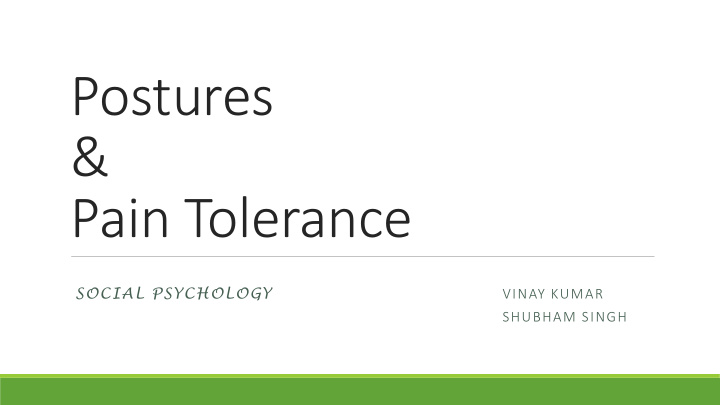



Postures & Pain Tolerance SOCIAL PSYCHOLOGY VINAY KUMAR SHUBHAM SINGH
Introduction Pain appears as: Physiological as well as Psychological self-efficacy beliefs and perceptions of control as determinants Physical Toughness, resistance to pain generally seen as causes of dominant display, not effect.
What recent studies suggest! Expansive postures: hormonal changes (i.e., increased testosterone, decreased cortisol) Constrictive postures: with opposite effects Testosterone -> expectations of success and overconfidence, and higher pain tolerance. Elevated cortisol-> response to pain. Postures associated with power can produce elements of actual power. *Cortisol-> level increases as a result of physical stress.
What we want to achieve Can Adopting postures or interacting with someone who adopt these, influence pain tolerance? Can posing as if one possesses power produces similar effects as actually possessing power? individual's pain threshold through two means — one intrapersonal, and one interpersonal.
Hypothesis 1. whether postures affect pain thresholds. 2. Individual’s sense of embodied power affected by behavior of interaction partner. Consequently experience the same physiological effects as in hypothesis 1.
To test hypothesis 1 Participants assigned one of the 3 postures as shown Dominant <-> Submissive <-> Neutral
To measure pain thresholds Postures held for 30 seconds. Tourniquet technique A blood pressure cuff. Measuring Pain Threshold in mmHg! To ensure no priming effect. Readings are averaged over 3 times in a day. *Poses based on Tiedens and Fragale's (2003) description of non-verbal dominance
Well we hope to add this as well We are thinking of measuring hand grips as well Using hand dynamometers (only if we get one)
To test Hypothesis 2 Individual’s sense of embodied power affected by behavior of interaction partner. Complementary pose is adopted.
Recent Research Suggests that when one interaction partner displays a “power pose” , the other interaction partner is likely to display a submissive pose.
Can be summed up as “interacting with a dominant confederate would lead participants to display lower pain thresholds”.
Lets do it Measure Pain Threshold Participants Engaged in some discussion task with confederate. Confederate takes dominant postures for half the sessions. Changes are observed on the Participant’s behaviour Pain thresholds are measured again *Make sure participants do not suspect that the other guy is a confederate.
Dominant Postures open body postures, speak loudly, and reduced the physical space between themselves and their counterparts ( if applicable )
Submissive Postures closed body postures, speaking softly, and preserving the physical space between themselves and their counterparts.
Significance of the results power posing as useful tool for pain management. individuals with no control over their circumstances to benefit. subtle interpersonal interactions with caregivers and doctors to influence individual's pain tolerance findings could highlight the dynamic social and interpersonal nature of embodied power. An important means of integrating social psychology with embodiment research
Compare hypothesis 1 with 2 Simply perceiving or thinking about a powerful person to have different psychological and physiological effects than actually interacting with that person.
References 1. It hurts when I do this (or you do that): Posture and pain tolerance Vanessa K. Bohns , Scott S. Wiltermuth . 2. Al'Absi, M., Peterson, K. L., & Wittmers, L. E. (2002). Adrenocortical and hemodynamic predictors of pain perception in men and women. Pain, 96, 197 – 204. 3. Averill, J. R. (1973). Personal control over aversive stimuli and its relationship to stress. Psychological Bulletin, 80, 286 – 303. 4. Carney, D., Cuddy, A. J. C., & Yap, A. (2010). Power posing: Brief nonverbal displays affect neuroendocrine levels and risk tolerance. Psychological Science, 21, 1363 – 1368.
Recommend
More recommend